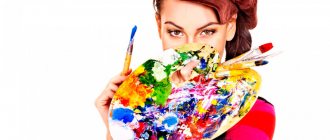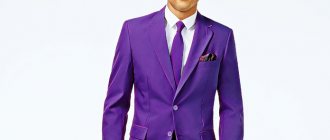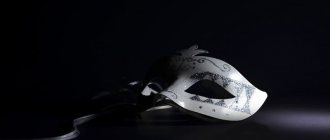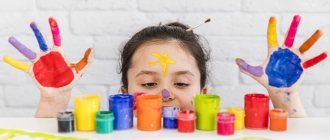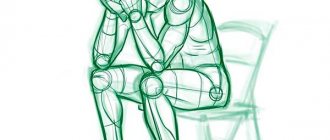Every day, color surrounds every person everywhere, evoking unique feelings and emotions. The choice of interior and household items, accessories, improvised means, clothing, and everything else according to the shades of the color palette indicates the personal preferences, internal sensations and state of mind of the individual. Also, personal preferences for colors characterize the mood of the upcoming event or temperament.
The choice of color tone radically affects the psycho-intellectual state of the individual. Psychologists have determined that an environment with a restrained color scheme attracts, calms, promotes a creative atmosphere, and improves communication between people. Color tone can influence feelings, not logic. Studies have proven that 80% of color is “absorbed” by the nervous system, and 20% by vision. There is a certain relationship between color and perception. It has been truly established that every color tone has subconscious associations. Color, like shape, has an emotional impact on any personality. It can instill feelings of comfort and peace, attract or repel, disturb or excite. This can be clearly observed when leafing through booklets, watching good advertising films or looking at posters, glancing at the expressive spatial and color solutions.
Primary colors and their meaning in psychology
It is no secret that the choice of one color or another characterizes a person in some way. So, let's look at these characteristics, and also find out how and what shade affects our psyche and what significance it has.
Purple color in psychology
A) The meaning of purple in psychology
It’s very difficult to call this color natural – it seems to give off a feeling of some unnaturalness. However, this color also symbolizes luxury, wealth and mystery. The main symbol of this color in psychology is the owl, because purple symbolizes wisdom and mysticism. According to medieval myths, purple is also considered the color of repentance and loneliness.
B) The effect of purple on the human psyche
This is a very dangerous color, as it puts pressure on the psyche and can cause apathy - which is why try to use it in small quantities in the interior. However, shades of purple can help a person increase self-esteem, have a positive effect on the development of big plans, and help develop sensitivity. In addition, in moderate doses it has a calming effect on the psyche.
C) Characteristics of a person whose favorite color is purple
It is often believed that the color purple is preferred by people who find it difficult to achieve fulfillment in life. We are talking about very self-critical natures, inclined to constantly keep themselves under control. At the same time, they need support and support, and, at times, are distinguished by noticeable sentimentality and infantilism.
Blue color in psychology
A) The meaning of blue in psychology
This color has a peculiar symbolism, distinguished by both positive and negative aspects. Positive characteristics include perseverance, idealism, fortitude, organization, and rigor. Negative characteristics were: weakness, fanaticism, dependence. Although most people still associate blue with the sky and eternity. It also symbolizes honesty, loyalty, constancy.
B) The impact of blue color on the human psyche
Shades of blue are famous for their calming effect, and for this reason they are often used in the interior design of bathrooms and offices. However, it is rarely used in children's rooms, since blue is a cold shade, and because of this, the baby may feel uncomfortable. However, in any room, it is recommended to dilute the blue color with other, warmer tones, in order to prevent the development of prolonged depression and anxiety.
C) Characteristics of a person whose favorite color is blue
People who love the color blue are often modest and reliable. They are often prone to melancholy, love solitude, are prone to long thoughts, and try to avoid conflict situations. In general, they are characterized by sociability and a tendency to idealize the world around them.
Green color in psychology
A) The meaning of green in psychology
Green color is formed by the fusion of blue and yellow, and as a result complements the qualities of both. It is a symbol of life opportunities, tranquility, steadfastness, prosperity and inner harmony.
B) The impact of green on the human psyche
Things in green shades have a disciplinary effect on their owner and help fight various fears and complexes. It is also worth noting that this color has a neutralizing effect on other colors and helps dispel negative emotions, in return giving peace and tranquility. Among other things, it helps to come to a decision even in the most difficult situations. Some people attach negative aspects to this color - silence and hopelessness. It is believed that you should not concentrate on this color for a long time - this will cause boredom and apathy.
C) Characteristics of a person whose favorite color is green
As a rule, people who like this color are characterized by high efficiency and a desire for leadership. They can predict the development of almost any situation and come out of it with maximum benefit for themselves. They often help others, even if it causes harm to themselves. They are very secretive, but at the same time strive for sociability.
Red color in psychology
A) The meaning of red in psychology
Red is primarily associated with blood and fire. The symbolic meanings of this color are varied and sometimes even contradict themselves. For many, the color red symbolizes love, passion, and fullness of life. Others, in turn, consider red the color of war, bloodshed, and revenge. In ancient times, the color red often meant a certain aggressiveness and strong sexual desires. This color also signifies greatness and power. For example, in Byzantium, only the empress had the right to wear red boots.
B) The impact of red color on the human psyche
Red is very exciting and hot. Many people associate it with something dangerous, illegal (just remember a traffic light). Also, this color easily attracts attention - advertising producers actively use this. If a person looks at this color for a long period of time, he will notice an increase in heart rate. And yet, it is undesirable to overuse red - it soon begins to tire you.
C) Characteristics of a person whose favorite color is red
It is believed that lovers of red are born leaders. They also vigorously express their emotions and experience them vividly. Most often, admirers of red are distinguished by persistence, selfishness, and intolerance. Women who love shades of red are usually quite sexy and often prone to flirting.
Yellow color in psychology
A) The meaning of yellow in psychology
As you know, this is the color of the sun, optimism, wealth and joy. Many people have just such associations when they see the color yellow. Yellow embodies energy, positivity, movement, and cheerfulness. At the same time, it also has negative meanings - its golden glow causes associations with greed for some. Many also consider yellow to be the color of separation, betrayal, and jealousy.
B) The impact of yellow on the human psyche
In psychology, it is believed that, first of all, the color yellow symbolizes active mental activity. According to the results of numerous studies, it is these shades that have a stimulating effect on those areas of the brain that are responsible for thinking and memory. It is argued that systematic, but rather moderate perception of yellow has a positive effect on intellectual abilities.
This color also helps to resist chronic fatigue, mild depression, and apathy. However, note that an excess of this sunny shade can cause harm in the form of hidden nervous disorders.
C) Characteristics of a person whose favorite color is yellow
A person who gives preference to the color yellow strives to reveal himself in any way and wants to achieve his goals at all costs. These people are often in high spirits, very confident, sociable and creative. At the same time, they can be absent-minded and quite critical of both themselves and other people. They rarely suffer from low self-esteem.
Orange color in psychology
A) The meaning of orange in psychology
Basically, this color is a symbol of solar warmth and internal energy. It is also strongly associated with fiery emotions, rhythm, and energy. In other words, this color in psychology has practically become synonymous with constant movement, symbolizing love of freedom, talent, and versatility. In the minds of many people, this color is characterized by positive and life-affirming energy.
B) The effect of orange on the human psyche
Note that we are talking about a rather complex shade, which is a mixture of red and yellow. As a result, the influence of this color depends on which shade became the leading one. The dominance of yellow color has a softer effect on the psyche, giving a positive perception. If the red hue predominates, then it has a different meaning on perception, being associated with strength and assertiveness. Also note that an excess of orange negatively affects a person’s mental state, causing fatigue and mental exhaustion.
C) Characteristics of a person whose favorite color is orange
People who love orange are usually rare optimists. They are characterized by good nature and a positive outlook on the world around them. Most often, they are very sociable and have high energy potential. Sometimes, excessive assertiveness can be considered a negative trait.
Black color in psychology
A) The meaning of black in psychology
Often this color symbolizes mourning, death, misfortune. Black carries a certain protest, denial, because it is not for nothing that most of the unkind characters in fairy tales and films are dressed in dark robes. However, some are inclined to consider black to be the color of mystery, elegance, and completeness.
B) The impact of black color on the human psyche
Black absorbs light and has a strong influence on the psyche of any person. It often turns out to be one of the signs of depression, melancholy, uncertainty, and depression. At the same time, it provides an opportunity to relax and come to some rethinking. Black color allows you to take a break and get to the bottom of the truth, pushes you to think.
C) Characteristics of a person whose favorite color is black
In general, people who love the color black are often very mysterious individuals. Moreover, without realizing it, they strive to attract the attention of others, because the black color arouses curiosity, as if hiding something interesting and intriguing behind it. Moreover, if black colors predominate in your life, it is likely that you feel a lack of certain emotions or feelings. Also, black color characterizes several secretive natures.
Pink color in psychology
A) The meaning of pink in psychology
The color pink is considered a symbol of romance, love and kindness. It seems to be imbued with a bright aura of innocence and serenity. Lightness, tenderness, calmness and love of life “live” in this color.
B) The effect of pink on the human psyche
Despite the fact that pink contains the presence of an aggressive red color, it still has a relaxing effect on the human psyche, relieving irritability and anger. By the way, in institutions where they work with children with antisocial behavior, the walls are often painted pink precisely for this reason. A soft pink tint has a positive effect on the nervous state, but its excess is harmful to melancholic people. It is also believed that contemplating the color pink helps get rid of headaches.
C) Characteristics of a person whose favorite color is pink
People who prefer pink need tenderness and love more than others. In addition, they are capable of becoming restless for any minor reason. Lovers of pink strive for the fullness of life, looking forward to thrills and vivid impressions. At times, they are characterized by immaturity and frivolity, but they can also often turn out to be very hardworking individuals.
Lilac color in psychology
A) The meaning of lilac in psychology
Symbolizes nostalgia, anticipation of a bright future. It is a mixture of blue and red, two principles - masculine and feminine. It is also often associated with vanity and immaturity. Among other things, it is considered the color of untapped opportunities, strong affection, and vigilance.
B) The impact of lilac on the human psyche
In fact, we are talking about a very lively and bright color, but in psychology there is an opinion that it can cause a clear feeling of restlessness and anxiety. It is for this reason that if you have to go to an important meeting, try to avoid clothing in shades of lilac (although certain elements are allowed). This may antagonize your interlocutor, which will certainly not be good for you.
C) Characteristics of a person whose favorite color is lilac
Lilac lovers are creative, sensitive and, at times, quite childish. Their distinctive features include distrust, patience, and secrecy. They often steadfastly cope with the trials that fate sends them and are ready to provide free help to other people. Despite outward optimism, they have a tendency to depression, from which they are able to get out on their own. They rarely blame others for their troubles; they strive for originality and uniqueness.
White color in psychology
A) The meaning of white in psychology
White is a symbol of purity, joy, innocence, and a certain virtue. It evokes a strong association with daylight, true, purity. Although sometimes it is also given a different meaning. By its nature, it tends to absorb and neutralize other colors, and, accordingly, correlates with incorporeality, emptiness, and even death. Note that the Slavs preferred to dress the deceased in white clothes. In addition, in China and some other Asian countries, white is considered a mourning color. But still, most people associate it with completeness and perfection.
B) The impact of white color on the human psyche
Often this color has a positive effect on a person’s psychological state. It calms and at the same time stimulates new achievements. However, it is worth noting that an overabundance of white in the interior or external appearance can, over time, begin to tire and even irritate.
C) Characteristics of a person whose favorite color is white
People who prefer white color, as a rule, fully devote themselves to their chosen business. At the same time, they are often considered touchy, as they love loneliness and are not very keen on making new acquaintances. They are characterized by frequent disappointments and detachment. Although, at times, they try to open up to the world, they subtly sense lies, and have good intuition.
Blue color in psychology
A) The meaning of blue color in psychology
This is the color of water and sky, which symbolizes calm, lightness, airiness, and constancy. It is also a symbol of purity, dreams, and a bright mind. This color evokes associations with the vault of heaven, personifying softness and tenderness, something divine and sublime - it is for this reason that in ancient icon painting the halos of the gods were painted by masters in the color of heaven. Masons perceived blue as the color of spiritual perfection and enlightenment.
B) The impact of blue color on the human psyche
The color blue combines white and blue and therefore combines the effects of both. One part promotes relaxation and peace, creating the effect of freshness and coolness. The second part stimulates the work of the imagination and increases concentration. If you want a certain person to trust you, wear something blue to a meeting with this person. By the way, the mentioned color not only inspires confidence, but also demonstrates stability and evokes respect.
C) Characteristics of a person whose favorite color is blue
It is believed that the main adherents of the blue color are resourceful people who are used to tuning themselves to positivity and creativity. They are prone to experiments, unexpected creative solutions, and out-of-the-box thinking. Subconsciously they have a tendency towards melancholy and isolation. At the same time, they are self-confident and intellectually developed.
Turquoise color in psychology
A) The meaning of turquoise color in psychology
Turquoise is the color of sea wave, cyan. It contains shades of blue and green. Once upon a time, magical properties were attributed to turquoise - it was believed that this stone could protect against accidents. Symbolizes the desire for ideal, novelty. It is also a symbol of calm and regularity. Evokes associations with sea waves, purity, happiness, innocence. In some European countries it means intuition and healing.
B) The impact of turquoise color on the human psyche
This color manages to exude calm and give a feeling of absolute balance combined with growing energy. He has the power to charge our thoughts with optimism and a light mood, to relieve stress and overwork. By focusing on the color turquoise, a person begins to feel more peaceful.
C) Characteristics of a person whose favorite color is turquoise
It is believed that people who like the turquoise color are very easy to communicate, sociable, open and friendly. They are also distinguished by compassion, empathy and emotional sensitivity. They have remarkable intuition and are determined to create harmony in their lives. Despite external calm, they can mentally experience a lot of different emotions.
Brown color in psychology
A) The meaning of brown in psychology
The color brown symbolizes earth, fertility, and tree bark. At the same time, it is a symbol of stability, reliability, stability and devotion. In psychology, all shades of brown are considered to be the colors of comfort, coziness, security and sensuality.
B) The effect of brown on the human psyche
This color has a rather complex structure, and because of this it is characterized by the qualities of warm and cool colors. For example, light shades of brown with an orange undertone have a warming effect.
In general, warm shades of brown are quite helpful in relieving stress. It is especially recommended for use in the interior and wardrobe of people who are afraid of change and are prone to frequent anxiety. Being the color of stability, brown gives a feeling of security. It also helps build self-confidence and inspire respect - for this reason, psychologists recommend wearing brown clothes before important business meetings.
C) Characteristics of a person whose favorite color is brown
The attraction to brown shades is characteristic of practical and serious people. They have clear goals and generally want to succeed. They are very skeptical about their attitudes towards dreamers and infantile individuals. They respect traditions, are distinguished by punctuality, close ties with family, and reliability. At the same time, they may lack ease of communication and inner freedom.
Light green color in psychology
A) The meaning of light green color in psychology
The cool light green shade symbolizes tranquility, food, nature, peaceful contemplation and is a very sophisticated shade. In general, light green is considered a combination of yellow and green, and for this reason has similar characteristics to them. As a result, this color evokes associations with such concepts as peace, tranquility, and optimism.
B) The impact of light green color on the human psyche
In general, light green has a positive effect on the human psyche. If it is not endowed with modern “acid” shades, then its contemplation can prompt positive thoughts and push to some new achievements. In turn, the mentioned “acid” shades can cause a feeling of irritation in some.
C) Characteristics of a person whose favorite color is light green
People who prefer light green color are most often very loyal to others, but at the same time self-critical. From time to time they have fears that someone may judge them, condemn them, and so on. Also, light green lovers often prefer not to give in to passions and are very stingy with emotions in their personal lives.
Burgundy color in psychology
A) The meaning of burgundy color in psychology
Burgundy color is considered a symbol of strength and vitality. It is also associated with perseverance, restraint and determination. In addition, power and strength can be called significant meanings of this color. Burgundy is a symbol of solidity, confidence and conservatism. Some people associate it with the color of antiquity, but if it is combined with gray, it immediately becomes a symbol of prosperity and solidity.
B) The impact of burgundy color on the human psyche
It is believed that an excess of this color in clothing or in the interior can have a detrimental effect on the psyche, causing depression - which is why it is advisable to use it in moderation. At the same time, it belongs to the category of exquisite colors and evokes appropriate emotions.
C) Characteristics of a person whose favorite color is burgundy
Fans of burgundy color, as a rule, have a large supply of energy, but at the same time they show their own emotions very sparingly. However, this does not prevent them from being assertive individuals who have remarkable organizational skills. They are often inclined towards creative professions and are keen connoisseurs of art. They are also self-confident and enterprising.
Beige color in psychology
A) The meaning of beige in psychology
This color is a symbol of warmth, regularity, comfort and harmony. Unfortunately, it also has negative symbols - boredom, sadness, routine and monotony. Different countries have different attitudes towards this color. For example, in China, beige, like white, is associated with mourning. At the same time, in India, the color ivory was always held in high esteem - things of this color, as a rule, were only allowed to noble persons. In turn, Ancient Egypt was famous for its figurines of deities painted beige. As a result, we can conclude that this color is associated with a certain mystery, enlightenment, and divinity.
B) The impact of beige on the human psyche
The beige color has such a quality as neutralizing aggression. For example, people who find themselves in a room with beige interior elements soon experience peace and relaxation. It is also worth noting that all shades of this color contribute to a good rest.
C) Characteristics of a person whose favorite color is beige
People who are at the stage of searching for their “own self” often become adherents of beige. They do not want to somehow stand out from the general number of people - moreover, they want to be unnoticed. They are often unsure of themselves and doubt their own taste, and do not strive for leadership. At the same time, they can be called very sincere individuals who really value practicality. As a rule, even in difficult situations they strive to maintain a neutral position.
What do psychologists say about blue lovers?
Psychology identifies people who love the color blue as introverts. Their predominant qualities are focus on their own development and achieving harmony with themselves. Sometimes such behavior is mistakenly perceived by others as selfishness and narcissism.
In contrast to the meaning that the turquoise color suggests in psychology, the characteristics of blue color lovers combine 3 qualities: perseverance, uncompromisingness, determination. Because of their ability to actively defend their point of view, such people may seem hot-tempered and even aggressive.
Psychology of color in clothing
Perhaps you have wondered why you often buy clothes sticking to one color scheme? For what reason do our hands reach out to wardrobe items of the same colors, and at the same time we completely ignore other color schemes? As a rule, we do not think about it, or we simply come to the conclusion that the purchase was made according to our mood, without carrying any subtext. And yet, psychologists are inclined to believe that this does not happen - there are reasons for everything. By the way, you can give preference to one color scheme for many years, but one day you buy something with a completely atypical color for yourself.
How can you explain, for example, the fact that you have always loved things in pastel colors, but one day you decided to buy a bright red dress? Some time passes and you begin to regret this spontaneous purchase, although the first thing you should do is carefully analyze it. In fact, you just have a desire to cheer yourself up, and, most likely, it will soon return again. It’s just that your brain sent you an impulse that there are not enough bright changes in your life.
In general, a constant preference for certain colors can characterize your character. If such “outbursts” periodically occur, like the situation with the red dress, then this indicates what kind of mood you were in at a certain moment in your life, perhaps it was about a few minutes of it, or about a big new stage.
Based on this, it is obvious that we can influence our mood and well-being, knowing which aspects are characteristic of a particular color. That is, you yourself can set the direction of your mood by dressing in things of certain tones. You can study the definition of colors in the previous paragraph.
Characteristics of people who love yellow colors
Regarding those who love the color yellow, psychology contains the following information: these people are positive and selfless. They are easy to talk to, make contact easily, and have good communication skills. However, sometimes their behavior is perceived as frivolous and frivolous. Therefore, yellow clothes are not worn when going to important business meetings or interviews. Unlike those who love blue, psychology gives a one-word answer: optimists prefer yellow; people overflowing with vital energy. They easily share their good mood, are kind by nature, and show generosity.
Psychology of colors in the interior
Most likely, you have already been able to verify from your own experience that the color of the walls of the room you are in can influence your mood and radically change it in both positive and negative directions. Of course, it is for this reason that you need to approach interior solutions with special attention.
It is obvious that color is one of the most important components of the environment, and it has the power to make adjustments to our well-being and mood in life. If you skillfully use colors and their combinations in the interior of a particular room, the result of such efforts will be a feeling of comfort and coziness. Otherwise, often being in a room with poorly chosen colors, you will only feel anxiety, apathy or despondency.
Surely, you have heard that dim, light and cool shades that have a minimum of contrast can visually “push apart” the walls of the room, and as a result it will seem more spacious than it really is. In turn, dark and warm shades visually narrow the space.
As you understand, a certain color can not only improve the interior of a home, but also ruin it. Study this issue carefully, study the nature of color and take note of the most successful color solutions. As we already mentioned, there are warm and cool colors, and the overall impression of the room will depend on which color you choose.
What do psychologists say about lovers of turquoise?
Many lovers of the color called aquamarine are interested in whether the turquoise color has any meaning in psychology. As with other shades, it carries a certain meaning and reveals the main character traits of people. There are several explanations for what the color turquoise means in psychology: calm, measuredness, gradual achievement of one’s goals.
Aquamarine lovers are non-conflict, sociable, and easy to compromise. They do not know how and do not strive to manipulate people, but due to their soft character they easily find themselves under the influence of others. Those who choose the turquoise color are honest, simple, direct, being within the framework of other people's conflicts, and take a position of neutrality.
How does color affect a person and his life?
Many seriously underestimate the influence of color on a person’s well-being and mood. At times, color can influence the occurrence of certain reactions, which subsequently directly affect important decisions. For example, color can affect a person’s blood pressure and appetite, without him even noticing it.
Remember what feelings you often experience on a cloudy and damp day, looking out of the window and getting ready to leave the apartment. Seeing the grayness behind the glass, you probably feel a significant deterioration in your mood. Positive energy seems to disappear somewhere and the world around begins to evoke unpleasant emotions. It’s unlikely that you have thought that the reason for all these bad moods is precisely the perception of color.
Some time ago, medicine began to pay closer attention to such a phenomenon as color therapy. What is the essence of this technique? Color is used as one of the ways to influence the emotional, mental and even physical state of the patient. The basis of the technique was the wavelength of each color - it turned out that each length has a specific effect on the human body.
By the way, color as one of the aspects of treatment has been used since the existence of ancient civilizations. For example, in ancient Egypt, special rooms were allocated in temples in which the refraction of sunlight took place - this subsequently influenced the appearance of different colors of the spectrum. The person seemed to be bathed in bright colors, and this technique even got its name - “Ra-therapy”. Today, this unusual treatment method has been replaced by chromotherapy, a science that studies how certain colors affect human health.
Burgundy
The color is formed by mixing red and brown. It has a deep, rich hue , which is calmer in effect than bright red. Does not cause severe stress to the nervous system.
Burgundy is the color of the elite; it is chosen by people endowed with conservative qualities and representatives of the business sphere.
Speaks of confidence and solidity . They are good organizers, but at the same time stingy with emotions.
Burgundy is used in clothing. It also looks good in the interior, creating a feeling of solidity and wealth.
Violet
The color of human spiritual strength. Helps you focus on the main thing and inspires inspiration. He is loved by creative people, people with unconventional thinking, he is able to balance the spiritual and material. Associated with something exclusive and creative. The color violet stimulates brain function well; it is often used on packages of chocolate, raisins, and nuts. Recently, purple has often been used in the design of modern interiors; previously it was considered a majestic color, which was always present in the clothes of kings.
Possible negative associations: Lightning is often depicted in shades of purple, which evokes thoughts of the supernatural and mystical. This color can be perceived in completely different ways; for some it is the color of power, spirituality and wisdom, and for others it is fanaticism, alienation and even death.
Grey
Gray color connects white and black, forming a harmony of two opposite colors. Neutral in itself, it has a subtle beauty, especially when combined with bright colors. Gray is the color of intelligence, it relaxes and helps you feel calm. It is universal and conservative, can be used in almost any field of activity to create brevity and sophistication.
Possible negative associations: Gray can be associated with bad weather, illness, feelings of uselessness, melancholy, and fatigue. His capacity for peace may be replaced by a feeling of endless melancholy and sadness. It is rarely used when creating packaging for detergents, shampoos, and hygiene products, because... in the psychological perception of people, gray is the color of the city, modern offices, asphalt, dust, but not shampoos.
Brown
Brown is the color of strength, solidity, stability, practicality. Brown symbols: soil, tree, earth, autumn. It has abstract symbols - hard work, endurance, conservatism. Brown, along with black and navy blue, often dominates the clothing of rich and confident people, which emphasizes their sense of self-worth. Brown is the color of coffee and aromatic spices; it is exquisitely used in the interior design of coffee shops and restaurants. People who prefer this color desire physical relaxation, peace, and concentration, so it can be used in office themes.
Possible negative associations: Brown color may seem boring, even depressing, and may cause associations with tobacco, smoking, and unpleasant odors.
Green
Green is the color of life and nature, symbolizing prosperity and new beginnings. It heals, relaxes and softens a person, so it is often used in the design of medical institutions, on the packaging of medicines, cosmetics and detergents. Green neutralizes the effects of other colors and helps dispel negative emotions. Brings calm and tranquility, helps to concentrate and make decisions. Has a strong association with spring, youth, renewal and naturalness.
Possible negative associations: In large quantities it causes excessive relaxation, turning into lethargy, boredom and laziness, so it should be combined with other colors. A color that doesn’t demand anything and doesn’t call anywhere (looks past everyone). It has many shades, which sometimes give completely opposite meanings. “Green” is what professionals call an untrained person, a beginner (meaning inexperienced, young). Green color is avoided on sweet packaging because... psychologists have proven that in people’s perception the color green is “bitter” or “sour”, but not sweet.
Color therapy
It's no secret that there is a connection between human qualities and colors. Depending on the mood and condition, a person may prefer one shade or another.
Each color has its own unique characteristics:
- contributes to the creation of a favorable or tense atmosphere;
- determines mood;
- associated with a particular time of year;
- awakens feelings, gives color to surrounding things;
- has an attractive or repulsive effect.
Impact on everyday life
Any color can directly or indirectly influence certain events in a person’s life and his character. From an early age, a person is asked questions regarding his favorite color. Each thing and object has its own shade. Therefore, when making purchases, a person looks for an item of his favorite color.
When it comes to global purchases, there may be variations. But the main thing is to take into account the relationship of color with the purpose of using the purchased item. If we are talking about a car, then orange or bright pink color will not be entirely appropriate, since such a car acts very irritatingly on the road and attracts a lot of attention. In this case, it is better to give preference to cool and neutral shades.
If we are talking about home furnishings, then each room in the apartment requires a special color scheme. If we are talking about a bedroom or recreation room, then you should choose warmer and pastel colors. Bright colors can be used in the nursery, the main thing is to maintain a sense of proportion. The kitchen can also look slightly contrasting.
Black
Black always hides everything it carries, being the most “mysterious” color. Balances white color (without darkness there is no light, yin and yang). Correlates with infinity, helps to concentrate and isolate oneself from all extraneous colors. In its pure form, it is used quite rarely, because... causes negative emotions. It is usually paired with warmer, brighter colors to create more contrast. Black color is classic; black suits for men are an integral part of business style. Indispensable for creating clear shapes and lines.
Possible negative associations: Causes a feeling of bitterness, heaviness, despondency. Often associated with mourning. In this case, combining it with red can help; it will add dynamics and aspiration to black.
Vital activity
A representative of the stronger sex who prefers dark red shades is not uncommon today. Long gone are the days when men tended to choose dark colors. Now everyone is free to act according to their individual taste. As a rule, extraordinary individuals tend to dress brightly and look for additional perspectives that would allow them to more fully express their personal qualities. Life activity forces a person to move a lot, to feel the need to try to build life according to his own scenario, and not to adapt to those around him. Such an individual is not afraid to experiment and often makes completely rash decisions. If at some point something goes wrong, he can admit the mistake, although such a decision is not easy for anyone.
What to combine with?
Combining the red spectrum with other colors requires caution and a sense of style. To create a harmonious image, you need to select different colors. Burgundy can be one detail of the image or accessories. There is no need to overload the image: satiety with warm shades will make it flashy. Dark red is rarely used in interiors: it makes the room dark. Only a small number of parts are allowed. Burgundy-colored furniture looks good in a classic interior, but the walls should be light shades.
In the wardrobe, the most successful combinations of burgundy are with the following colors:
- Black. The combination with black is a stylish classic. This is a basic color that suits any look. In order not to make it too gloomy, you need to choose light versions of the red spectrum or dilute the image with other light colors.
- Gray. The combination of a cold gray shade with warmer ones forms a harmonious ensemble. It is advisable to choose lighter shades that will not overload the image. Gray adds elegance, makes the image strict, but not faded. Burgundy and gray are the best combination for business style.
- Blue. A good combination for an everyday look. Blue and burgundy form a harmonious image, do not weigh each other down and highlight the shades favorably. Various combinations allow you to create a work, sports or evening look.
- Green. Dark colors overload each other, so you need to be careful with this combination. To prevent green from making your outfit too flashy, you need to choose dark shades and break up the look with dark-colored accessories.
- Yellow. The bright, warm shade attracts attention, and when combined with a darker shade, it becomes even brighter. The yellow-red color scheme forms one of the natural combinations - shades of autumn foliage. Such clothes are suitable for people who are endowed with leadership qualities and like to be the center of attention.
- White. Against a white background, burgundy becomes brighter and more saturated, and white itself looks snow-white. The optimal proportion is an even combination of two colors. A dark shade is more suitable for the bottom, and a light shade for the top. The shades highlight each other and do not overload the image.
For special occasions, you can combine dark and light shades from the same or similar spectrums:
- Beige. A soft warm shade of burgundy will emphasize the richness and energy of burgundy. This combination is suitable for business lunches and more informal events.
- Pink. Bright, frivolous pink will dilute the severity of the outfit and make it more festive. In order not to turn the ensemble into a motley kaleidoscope that looks ridiculous, pink needs to be added carefully or choose very light shades.
- Gold. You need to add gold to an outfit in doses so that it emphasizes the luxury of the dress and does not make it vulgar. In this case, gold acts as decoration; there should not be a lot of it.
When choosing a burgundy outfit, you need to focus on the 1:2 formula. Burgundy should occupy no more than a third of the total area of the suit. If you add too many dark shades, the outfit will turn out gloomy.
